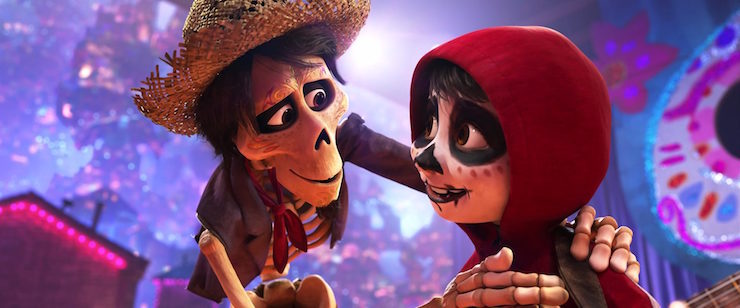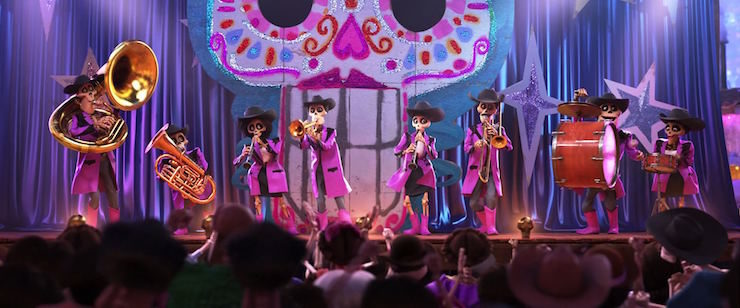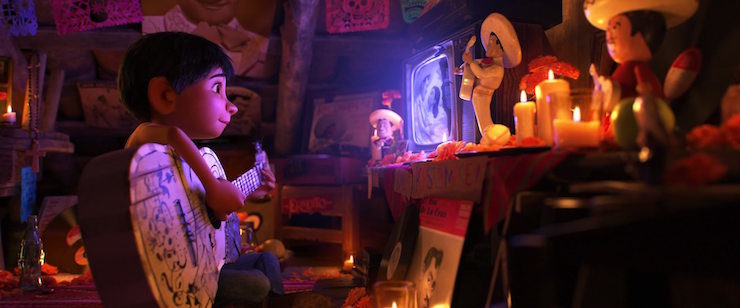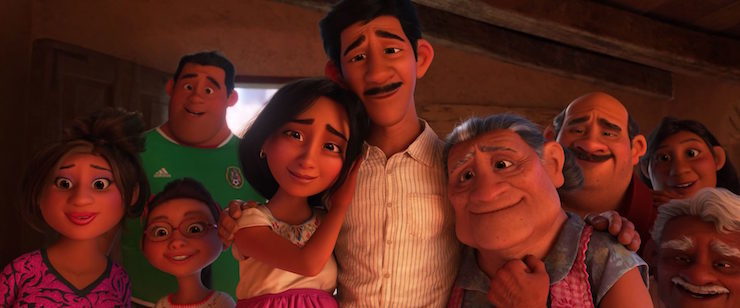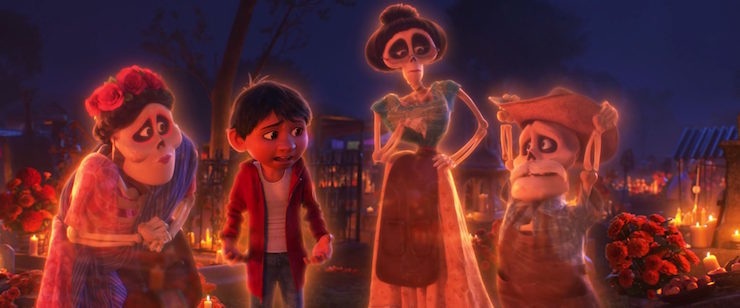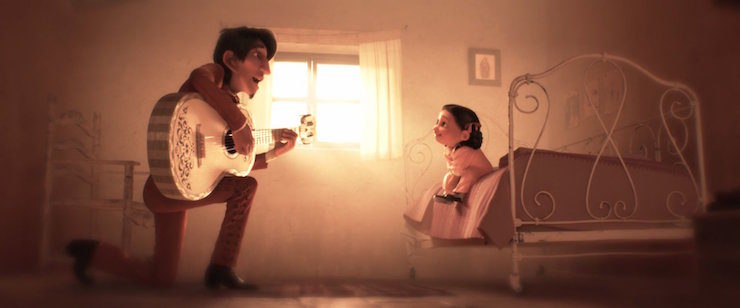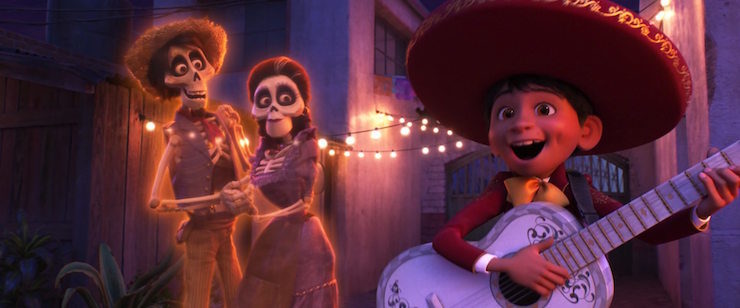When director Lee Unkrich first pitched the idea of an animated film focused on a Mexican protagonist, it was not a completely new idea for either Pixar or parent company Disney. Disney, after all, had released the goodwill tour film Saludos Amigos, a live action/animated attempt to introduce United States viewers to South American cultures, as far back as 1942, and followed that up with The Three Caballeros (1945), a deeply weird escape from World War II horrors, and, decades later, The Emperor’s New Groove (2000), which had a llama speaking with the distinctive tones of David Spade.
So, ok, it was mostly new—and even that was still more than Pixar had managed in its 18 previous films, beyond releasing a film featuring its protagonists travelling to South America (the 2009 Up) where they encountered Christopher Plummer, and having Buzz Lightyear briefly burst into Spanish during Toy Story 3. True, Pixar’s Ratatouille and Brave had at least explored non-American settings and accents, and the animation studio had sent its talking cars around the world in Cars 2. Still. Pixar and Disney both agreed that a touch more diversity would probably be a good thing, and gave Unkrich the go-ahead to start developing a film then tentatively titled Día de los Muertos.
Unkrich’s original thought was to have the film centered on a young Mexican-American protagonist, who would discover more about his past and his Mexican heritage. Día de los Muertos, with its focus on remembering people from the past, seemed like an ideal way to explore this concept. But as Unkrich worked on the plot and early storyboards, he ran into an immediate problem: as a white guy, he knew very little about Mexican culture. And many of the Pixar artists were in the same boat.
Initially, Pixar decided to handle this in the by now standard Pixar way of handling international locations and culture: travel, and lots of it. Rumors that the Día de los Muertos film was really just a way to get in some solid beach and scuba diving time have been officially denied by Disney, but Pixar did authorize multiple trips to Mexico, where artists sketched concept art and, as they later put it, soaked in as many colors as they could.
Still, Unkrich felt uneasy. To help with the story and script, he brought in new to Pixar writer/director Matthew Aldrich, to help brainstorm ideas and plot structure. After some more thought and discussion, he pulled in Adrian Molina as a screenwriter and co-director. Molina, a storyboard artist, had previously worked on Ratatouille, Toy Story 3, Monsters University and The Good Dinosaur. His script work, admittedly, had mostly been for the generally uninspiring The Good Dinosaur, but Molina was a second-generation Mexican-American, and the work he had done for The Good Dinosaur had a solid sense of family. It fit the theme.
Molina’s immediate problem with the film and its plot, however, had very little to do with specific aspects of Mexican culture, and a lot to do with the complete lack of stakes in a film where most of the main characters were already dead. The original plot had tried to add some tension to this by putting the dead characters under a curse that forced them to sing instead of speak in the Land of the Dead, but as an urgent motivating factor putting characters in peril this lacked something. Molina added a new element: the characters in the Land of the Dead would only be “dead,” not “dead dead,” though they could easily shift to that “dead dead” status once forgotten by the living.
With that urgency, along with adding a storyline that put Miguel in a touch of danger as well, Coco finally had a plot. Aldrich and Molina took several more trips to Mexico, visiting with various families and studying the culture of Día de los Muertos. Both also drew upon their own experiences: in Aldrich’s case, various blank spots in his own family tree that he had always wondered about, and in Molina’s case, dealing with his family’s expectations for his career. Molina also delved into various YouTube videos, studying different Mexican singers and Frank Sinatra, to help shape the various singing characters.
In by now classic Pixar fashion, the script changed again, and again, and then, just to keep everyone busy, again, as minor plot edits made to one point of the film ended up changing other points of the film. The songs, written by Robert Lopez and Kristen Anderson-Lopez (of Frozen fame), also needed to change right along with the script. And artists had to figure out a way to make the various dead characters move the way animated skeletons would, not the way people would—something partly accomplished through revised computer techniques, and partly through careful study of several anime films from Studio Ghibli, inspiration that the artists were careful to credit in various interviews. Thanks to all this, animation did not officially get pixelling until April 12, 2016—a good six years after Lee Unkrich had initially pitched the idea to Disney executives.
Perhaps as a nod to all this, Coco includes a glancing reference to past Pixar production problems, when one character decides to smash a Macintosh computer, calling it a “devil’s box,” presumably echoing some long held opinions of Pixar’s former partners at Apple. (Several people who worked on Coco started Pixar careers during the Steve Jobs years.)
Disney executives were adding some unneeded tension of their own, through a tone-deaf attempt to trademark the name Día de los Muertos, a move that was greeted with understandable uproar by several Mexican-Americans. In response, Disney hastily changed the title of the film to Coco, despite the rather large problem that using “Coco” for the title is a dead giveaway—forgive the pun—for one of the film’s major plot twists. To be fair, I think most viewers older than nine, and probably even many viewers younger than nine, could figure out that twist about midway through the film, but still, I can’t help thinking that Miguel might have been a better title. Moving on. Mexican cartoonist Lalo Alcarez, a particularly loud critic of the trademark attempt, was brought on as a consultant to the film, and reviewed scripts, concept art and storyboards.
Meanwhile, Pixar had another problem: thanks partly to script and production delays, the original actor hired to voice young Miguel had gone through puberty before he could voice the revised lines, forcing Pixar to recast that role. Fortunately, another young actor who had also auditioned for the role, Anthony Gonzalez, was still available, and eager to voice the now revised script. It was excellent luck for both Pixar and Gonzalez, who would later earn two awards in recognition of his work on the film.
Most of the rest of the voice cast, with two minor exceptions, were adults, and all, with just one minor exception, were Latino. That one minor non-Latino exception: Pixar stalwart and good-luck charm John Ratzenberger, who continued his tradition of voicing at least one role in every Pixar film with the blink and you’ll miss it one word role of Juan Ortodoncia, a man remembered by his dentist, Ratzenberger’s shortest ever voice role for Pixar.
Otherwise, the cast was entirely Latino. This had one additional benefit: several actors were able to voice their roles for both the English and Spanish versions of the film, most notably Gael García Bernal (probably best known to Tor.com readers for Y Tu Mama Tambien and Mozart in the Jungle), voicing desperate to escape the land of the dead Hector. A few, including Benjamin Bratt (presumably best known to everyone from Law and Order), voicing over the top singer Ernesto de la Cruz, voiced only the English version. Bratt also focused on the spoken parts of his musical role; most of the singing is the voice of Antonio Sol.
And just to drive in the Mexican setting, Coco even started off with a Latinized version of Disney’s theme song, “When You Wish Upon a Star,” before opening to the bright colors of Día de los Muertos.
Those colors form part of a rather clever animation technique: using animated cutouts to tell the story of Miguel and his musical hating family. It’s not an overly happy story: years back, Miguel’s great-great-grandfather, a musician, took off to pursue a musical career, abandoning his wife Imelda and his four-year-old daughter Coco. As a result, Imelda develops a deep resentment of music, to the point of completely forbidding it in the family and insisting that everyone just focus on shoes, a rule enforced by her granddaughter, Miguel’s Abuelita.
It’s not an entirely unhappy story either—the rest of the family members are close, loving and very into shoes, which becomes both the family business and a mild ongoing joke in the film. Miguel, however, is a different sort. Oh, he doesn’t mind cleaning shoes—but even then, he has a habit of drifting off and telling stories rather than focusing on cleaning shoes, and he is rather less than thrilled by the idea of learning how to make shoes. What he wants—desperately wants—is to be a musician. It doesn’t seem completely impossible—he has an old guitar and some old films of the great singer and guitar player Ernesto de la Cruz, which show just enough fingerwork to let Miguel teach himself how to play. Not to mention that those films show Ernesto de la Cruz, who comes from Miguel’s town, playing the same guitar that appears in the one old black and white photo showing Imelda and a baby Mama Coco, the same old guitar that Miguel uses—suggesting that Miguel might just be descended from Ernesto de la Cruz, and just might be meant to be a musician.
And the town has a talent show. If he can just play at the talent show, he can prove that he’s really a musician.
Unfortunately, this is also Día de los Muertos, a day, as his Abuelita points out sternly, meant for family, not for running off to talent shows, much less playing a guitar completely against the family rules. Indeed, she is so furious with Miguel for deceiving the family (he hasn’t exactly told them about the guitar before this) that she breaks his guitar right in front of him, despite a paternal protest. A desperate, sobbing Miguel takes off for the talent show anyway. When no one will lend him an instrument, he decides to take the guitar hanging right over the tomb of Ernesto de la Cruz—I mean, the guy’s family, right?
Lesson learned: grave-robbing, especially on Día de los Muertos, can be very dangerous.
It’s at this point that Coco becomes considerably more entertaining, as Miguel finds himself among the dead, eventually heading to the land of the dead to get everything cleared up. Entertaining for viewers, that is—poor Miguel soon finds that his dead family is not any more enthusiastic about his musical dreams than his living family is, a discovery that makes him determined to track down Ernesto de la Cruz for help. Helping him on his journey is a very cute dog and Hector, a dead man equally determined to make it back to the land of the living one last time before shifting from “dead” to “dead dead.” Hector is rapidly running out of time—as is Miguel, who needs to be blessed by a dead family member before sunrise, or be stuck in the land of the dead forever. GULP.
It’s all quite traumatic for Miguel, especially since he is absolutely determined to get his family’s blessing on his terms, not theirs. That is, he wants a blessing that will allow him to keep singing, something Mama Imelda is distinctly not in favor of. And he has to do quite a lot of running around and climbing and disguising himself, not to mention surviving nearly drowning and some major falls and some really major stage fright, plus making some uncomfortable discoveries about his family. It all leads to one massive tearjerker of a scene, even by Disney and Pixar standards, emotional enough to make even hard-hearted cynics like me just a tad sniffly. Just a tad. Or maybe I just really need to work on my dust problems. You decide.
Before that moment—punctured, in my theatre, by the gulps and sobs of from, I am certain, small children and not, say, grown-ups too big to cry over things like that—Coco offers several wonders: a dazzling, colorful cityscape that ranks among Pixar’s most imaginative backgrounds (Inside Out probably beats it, but just probably); characters that manage to look like walking skeletons, rather than walking people; glorious flying creatures; and, oh yes, songs.
Pixar films had, of course, had songs before this—most notably in the Toy Story movies, with “You’ve Got a Friend in Me” and the very sad moment when Jessie sings “When She Loved Me.” (Ok, I think we can all admit to sniffling during that, whatever our ages.) The Cars films had frequently featured classic rock songs. But most of the films had only featured a single song, if that, and used these songs as accents to the film, rather than plot points.
Coco, in contrast, takes the Disney approach of using its songs as actual plot points, with Miguel, Hector, Mama Imelda, Mama Coco and Ernesto de la Cruz all using songs and music to further the plot. Given that the film is mostly about one living musician (or wannabe musician) and a number of dead ones, this makes a certain amount of sense, but it also makes Coco yet another Pixar film that follows the post-Disney/Pixar merger of Disney films that “feel like” Pixar films, for want of a better term (Wreck-It Ralph, Big Hero 6 and Zootopia), and Pixar films that “feel like” Disney films (Brave, The Good Dinosaur, Coco).
Buy the Book
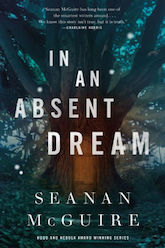

In An Absent Dream
Not just musically, either. Like several of the Renaissance Disney animated films, Coco features a young protagonist who does not feel he belongs—shades of The Little Mermaid, Beauty and the Beast, Aladdin, and later Frozen and Moana. Aside from one brief moment, Miguel spends most of the film insisting on his individuality and, for want of a better word, specialness—an insistence validated by the end of the film. Other Pixar films, especially Ratatouille, had played with these ideas, of course, but rarely made them as centric.
And, perhaps because the film was entering such new cultural territory for both Disney and Pixar, narratively, Coco plays it safe. Again, not unheard of for Pixar films. But for all its astonishing beauty—and this may well be Pixar’s most beautiful film ever—it remains predictable, with few to no narrative surprises whatsoever.
Then again, by the end, audiences may be sobbing too much—ok, finding their eyes too filled with dust—to notice.
Coco generated nearly universal critical praise, and—despite getting snubbed by both Worldcon members for the Hugo and SFWA members for the Bradbury—won two Academy Awards, for Best Animated Picture and Best Song. Equally if not more important from Disney’s point of view, Coco was a decided hit with audiences, bringing in $806.7 million worldwide in its initial outing, making it at the time the 15th most successful animated film ever. (As I type, Incredibles 2 has pushed this down to the 16th most successful animated film ever.) The film did particularly well in Mexico, grossing $792 million (Mexican)/$41.4 million American, at the time the second highest film gross for that country. Disney did not exactly pack the theme parks and stores with the same amount of merchandise that they would just a few months later for Incredibles 2, but did release the usual merchandise, including T-shirts, toys and trading pins. It was a sign, everyone agreed, that Pixar was back – and an encouraging sign for the next Pixar film.
Housekeeping note: Speaking of that film, unfortunately, thanks to the film’s strobe and other effects, I haven’t been able to watch Incredibles 2 yet, so that post will be delayed until that film is released on DVD/Blu-ray/streaming services.
Mari Ness lives in central Florida.










